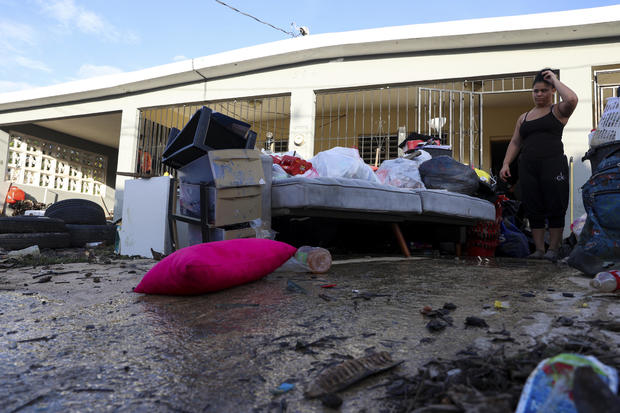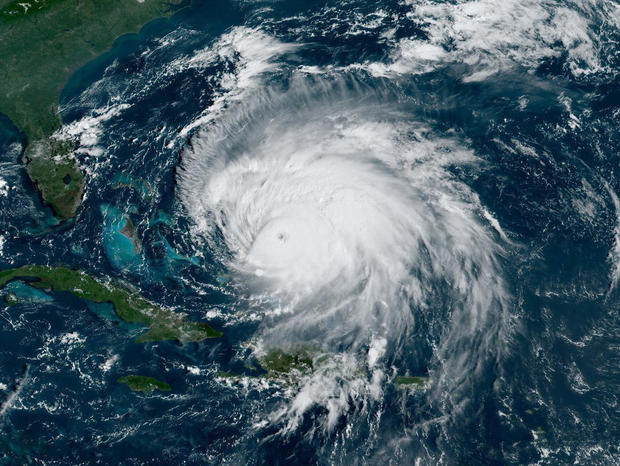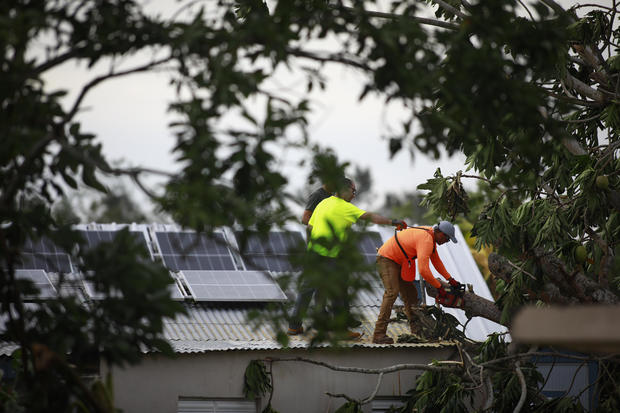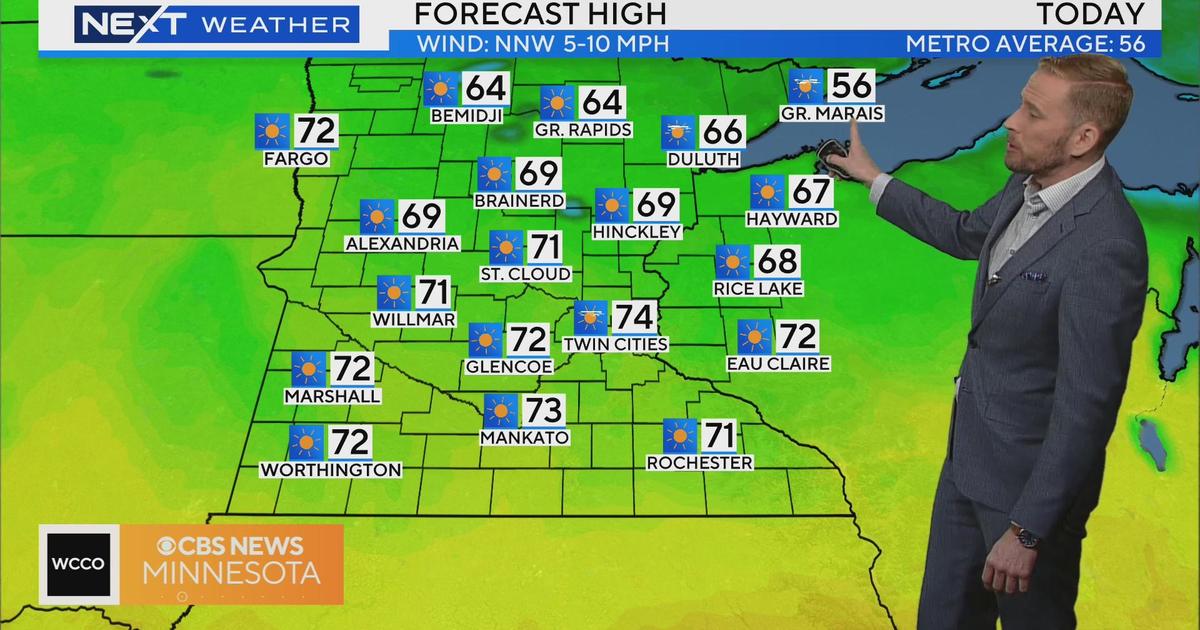Hurricane Fiona strengthens into Category 4 storm, heads toward Bermuda after pummeling Puerto Rico and other Caribbean islands
Hurricane Fiona strengthened into a Category 4 storm Wednesday after devastating Puerto Rico, then lashing the Dominican Republic and the Turks and Caicos Islands. It was forecast to squeeze past Bermuda Thursday before hitting easternmost Canada by late Friday.
The U.S. National Hurricane Center (NHC) said late Wednesday night that Fiona had maximum sustained winds of 130 mph. It was centered about 550 miles southwest of Bermuda, heading north at 10 mph. Hurricane-force winds extended 70 miles from the center of the storm, with tropical force winds extending outwards 205 miles.
The center of Fiona is expected to pass just west of Bermuda Thursday night, the NHC said, and will approach Canada's Atlantic provinces Friday. It will move into the Gulf of St. Lawrence Saturday.
The U.S. State Department had issued an advisory telling U.S. citizens to "reconsider travel" to Bermuda.
The storm was not forecasted to weaken until Friday.
"Little change in strength is expected through early Friday," the NHC wrote. "Some weakening is expected to begin on Friday, but Fiona is forecast to still be producing hurricane-force winds Friday night and Saturday after it has become post-tropical."
Bermuda could see 2 to 4 inches of rain from Fiona, the NHC said. When Fiona reaches Canada, it could bring Nova Scotia, Prince Edward Island and western Newfoundland anywhere from 3 to 6 inches of rain, while eastern Quebec could see 2 to 5 inches.
The storm has been blamed for directly causing at least four deaths in its march through the Caribbean.
More than a half million people in Puerto Rico remained without water service Wednesday, and many spent hours in lines to fill jugs from water trucks while others scooped water from mountain runoff.
Sweat rolled down the faces of people in a long line of cars in the northern mountain town of Caguas, where the government had sent a water truck, one of at least 18 so-called "oases" set up across the island.
The situation was maddening for many people across an island once again left without basic services following a storm.
"We thought we had a bad experience with Maria, but this was worse," Gerardo Rodríguez said in the southern coastal town of Salinas, referring to the 2017 hurricane that caused nearly 3,000 deaths and demolished the island's power grid.
Hundreds of thousands of people scraped mud out of their homes following what authorities described as "historic" flooding which dumped roughly two feet of rain on Puerto Rico.
The storm played havoc with Puerto Rico's electrical grid, which had been patched but never fully rebuilt after Hurricane Maria, which made landfall as a Category 4 storm five years ago, caused a blackout that lasted 11 months in some places.
As of Wednesday afternoon, three days after Fiona hit the island, roughly 70% of Puerto Rican customers lacked electricity, according to government figures.
The National Weather Service issued a heat advisory for San Juan because of the power outage.
The hum of generators could be heard across the territory as people became increasingly exasperated. Some were still trying to recover from Maria, which caused the deaths of an estimated 2,975 people.
"Hurricane Fiona has severely impacted electrical infrastructure and generation facilities throughout the island. We want to make it very clear that efforts to restore and reenergize continue and are being affected by severe flooding, impassable roads, downed trees, deteriorating equipment, and downed lines," said Luma, the company that operates power transmission and distribution.
Puerto Rico Gov. Pedro Pierluisi said Wednesday, "I continue to hope that by the end of today, a large part of the population will have these services."
Pierluisi also tweeted Wednesday afternoon that the federal government had approved a major disaster declaration request in response to Fiona. Earlier Wednesday, the Federal Emergency Management Agency (FEMA) had said the request was still under review. President Biden on Sunday approved an emergency declaration for the hurricane.
Deanne Criswell, the head of FEMA, traveled to Puerto Rico on Tuesday as the agency announced it was sending hundreds of additional personnel to boost local response efforts.
Meanwhile, the U.S. Department of Health and Human Services also declared a public health emergency on the island and deployed a couple of teams to the island.
The storm killed a man in the French overseas territory of Guadeloupe, another man in Puerto Rico who was swept away by a swollen river, and two people in the Dominican Republic: one killed by a falling tree and the other by a falling electric post.
Two additional deaths were reported in Puerto Rico as a result of the blackout: A 70-year-old man burned to death after he tried to fill his generator with gasoline while it was running and a 78-year-old man police say inhaled toxic gases emitted from his generator.
Luis Noguera, who was helping clear a landslide in the central mountain town of Cayey, said Maria left him without power for a year. Officials themselves didn't declare full resumption of service until 11 months after Maria hit.
"We paid an electrician out of our own pocket to connect us," he recalled, adding that he doesn't think the government will be of much help again after Fiona.
Long lines were reported at several gas stations across Puerto Rico, and some pulled off a main highway to collect water from a stream.
"We thought we had a bad experience with Maria, but this was worse," said Gerardo Rodríguez, who lives in the southern coastal town of Salinas.
U.S. Senate Majority Leader Chuck Schumer said Tuesday he would push for the federal government to cover 100% of disaster response costs — instead of the usual 75% — as part of an emergency disaster declaration.
"We need to make sure this time, Puerto Rico has absolutely everything it needs, as soon as possible, for as long as they need it," he said.
Many Americans hadn't heard from family members who didn't have electricity.
Palm Beach County, Florida, resident Nancy Valentin told CBS News, "I haven't been able to talk to my mom and see how she's doing."
At Boston's Logan Airport, those arriving from Puerto Rico recounted their fear of drowning in Fiona's floodwaters.
Yolanda Rivera told CBS News, "We stayed in one room in a little corner that was safe, for a whole night no light or nothing. The place was so dark."
In the Turks and Caicos Islands, officials reported minimal damage and no deaths despite the storm's eye passing close to Grand Turk, the small British territory's capital island, on Tuesday morning.
The government had imposed a curfew and urged people to flee flood-prone areas.
"Turks and Caicos had a phenomenal experience over the past 24 hours," said Deputy Gov. Anya Williams. "It certainly came with its share of challenges."






